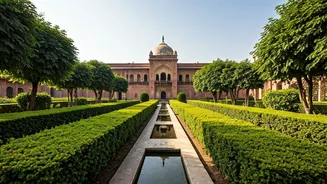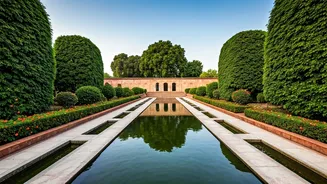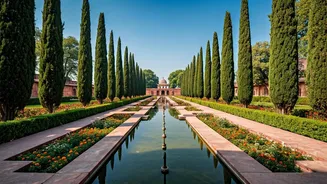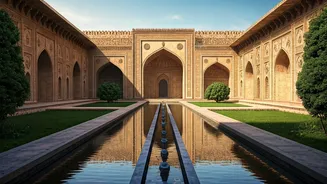Shalimar Bagh, Kashmir
Shalimar Bagh, nestled in the heart of Kashmir, is a true embodiment of Mughal garden design. This garden, originally built by Emperor Jahangir for his wife
Nur Jahan, is a testament to love and architectural prowess. It boasts a tiered layout, with pavilions and waterways enhancing the visual and auditory experience. The garden's strategic placement, overlooking Dal Lake, amplifies its beauty, offering breathtaking views that blend seamlessly with the surrounding natural splendor. The name 'Shalimar' itself evokes a sense of beauty and serenity, perfectly encapsulating the garden's essence and enduring appeal. The water channels and fountains, integral to the garden's design, create a soothing atmosphere and highlight the Mughal mastery of water management and aesthetics. This garden showcases how the Mughals skillfully integrated nature and architecture.
Nishat Bagh’s Splendor
Nishat Bagh, another gem in Kashmir, offers a different perspective on Mughal garden design. This 'Garden of Bliss' features a terraced layout rising dramatically from the shores of Dal Lake. Built by Asaf Khan, Nur Jahan’s brother, this garden presents a more expansive view of the landscape. Its design emphasizes a series of terraces that create a sense of movement and grandiosity. Each level offers unique perspectives and architectural details, enhancing the visitor's journey. The interplay of water channels, flowerbeds, and pavilions makes Nishat Bagh a dynamic and visually rich experience. The design principles include the characteristic Mughal elements of symmetry, flowing water, and meticulously planned layouts. This creates a place for both relaxation and reflection, showcasing the Mughals' ability to blend natural beauty with architectural precision.
The Beauty of Verinag
Verinag Garden, located in the Anantnag district of Kashmir, showcases the Mughal appreciation for natural springs. This garden surrounds a spring, the source of the Jhelum River. Emperor Jahangir built the octagonal-shaped stone enclosure around the spring. The garden's layout is simpler than other gardens, highlighting the natural beauty of the spring. The design focuses on the visual harmony between the water source and the surrounding landscape. Verinag Garden is a serene retreat, reflecting the Mughal preference for integrating natural elements. Its construction exemplifies how the Mughals skillfully incorporated existing natural features into their architectural designs. This garden provides a peaceful and reflective experience.
Humayun's Tomb Garden
Humayun's Tomb Garden in Delhi marks a significant shift in Mughal garden design, serving as an early example of the charbagh style. This garden is centered around Humayun's tomb, using a symmetrical layout with water channels and pathways. The charbagh design divides the garden into four quadrants, creating an organized and balanced structure. The garden’s design symbolizes the paradise garden, a crucial concept in Islamic architecture. The tomb’s central placement and the meticulous layout showcase the Mughals' sophisticated understanding of architectural planning and symbolism. The garden also served as a prototype for future Mughal garden designs throughout India, demonstrating its influential impact on subsequent architectural developments. This garden underscores the Mughals' commitment to integrating architectural and natural elements.
Taj Mahal's Paradise
The Taj Mahal Garden, located in Agra, is perhaps the most iconic example of Mughal garden design. This garden showcases the peak of Mughal architectural and horticultural prowess. The garden is perfectly symmetrical, reflecting the ideals of balance and harmony. The Taj Mahal's placement in the center is a testament to its status as a symbol of love and eternal life. The charbagh layout includes water channels, fountains, and pathways, enhancing the visual appeal. This garden integrates architecture and nature to create a stunning display. The meticulous planning shows how the Mughals combined beauty with spiritual significance. This garden remains a symbol of enduring love.
Mehtab Bagh's Vista
Mehtab Bagh, situated across the Yamuna River from the Taj Mahal, provides a unique perspective of the iconic monument. This garden, a late addition to the Mughal garden legacy, offers an unobstructed view of the Taj Mahal. Its layout is carefully designed to frame the monument. The garden’s design emphasizes simplicity and visual harmony, allowing visitors to appreciate the Taj Mahal from a distance. The placement of the garden, aligned directly opposite the Taj Mahal, offers ideal viewing positions. This garden enhances the overall aesthetic and viewing experience of the Taj Mahal. The planting scheme contributes to a serene ambiance, enhancing the architectural beauty of the Taj Mahal.
Yadavindra Garden
Yadavindra Garden, located in Pinjore, Haryana, showcases a blend of Mughal and Persian garden designs. Built by Fidai Khan, this garden features a series of terraces and water channels, creating a dynamic and engaging space. Its layout is more intricate, featuring various levels and architectural elements. This design represents a fusion of styles. The garden's location in a natural setting amplifies its beauty and tranquility, making it a place of rest. Yadavindra Garden reflects the adaptation and evolution of Mughal garden designs in different regions of India. The architecture and landscape elements create a serene experience.
Rambagh, Agra's First
Rambagh, in Agra, holds historical significance as one of the earliest Mughal gardens in India. This garden's design reflects early Mughal landscaping principles, including symmetrical layouts and formal plantings. Built by Babur, it offers an insight into the beginnings of Mughal garden traditions. The design showcases the initial integration of water features, pathways, and green spaces. Rambagh's significance lies in its historical role in the development of Mughal garden aesthetics. This garden provides a look at the early phases of Mughal architectural and horticultural endeavors. The serene environment offers visitors a peaceful retreat.
Khusro Bagh, Allahabad
Khusro Bagh, located in Allahabad, stands out for its blend of architectural styles. This garden is also a mausoleum complex, containing tombs of Prince Khusrau and other members of the Mughal family. Its design integrates Mughal and local architectural features. The garden’s layout, surrounding the tombs, creates a sense of solemnity and beauty. The architecture reflects the influence of various regional styles. Khusro Bagh is a showcase of cultural fusion in Mughal India. The intricate carvings and details highlight the artistic skills of the era. The garden provides an insightful glimpse into Mughal family history.
Lodi Garden, Delhi
Lodi Garden in Delhi is an example of the evolution of garden design. It contains structures from the Lodi and Sayyid dynasties. The garden’s layout combines elements of Mughal design with earlier architectural styles, which offers a unique mix of historical periods. This garden provides a peaceful retreat, showcasing the integration of historical architecture with natural landscapes. The tombs and other structures within the garden add to its historical importance and the cultural richness of Delhi. The blend of styles reflects the diverse history of Delhi. Lodi Garden's ambiance offers visitors a serene and culturally immersive experience.











